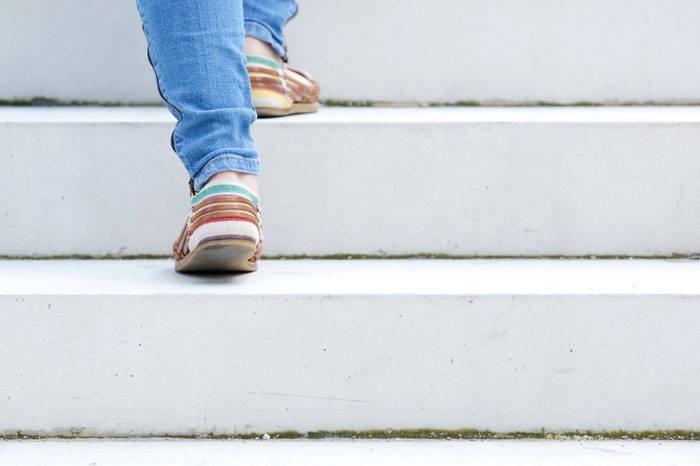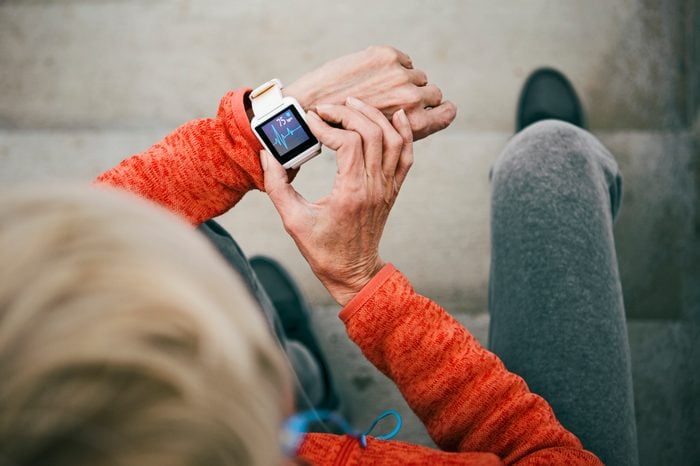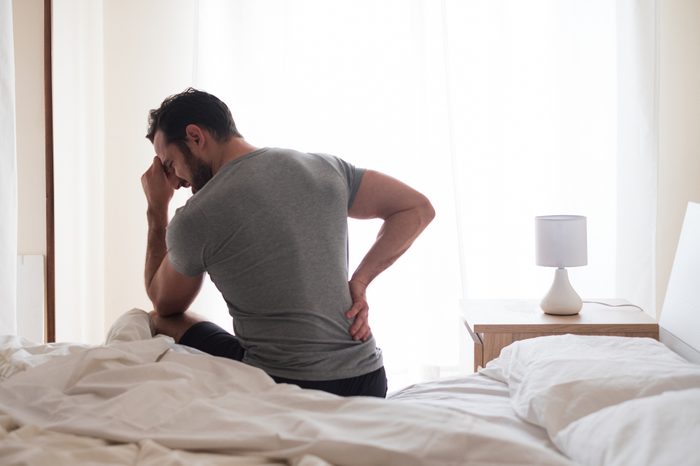
Signs you’re out of shape
You may huff and puff going up a few flights of stairs. Or you can feel out of breath and in pain with just a bit of exertion. Although this can happen occasionally to many people, sometimes it can be an indicator of poor cardiovascular health.
According to the World Health Organization, adults aged 18 to 64 years old should be engaging in at least 150 minutes of moderate-intensity aerobic physical activity throughout the week, or 75 minutes of vigorous-intensity. That’s because exercise has many health benefits include lowering blood pressure, preventing cardiovascular disease, improving depression, reducing chronic pain, and reducing stress. But, not everyone abides by these guidelines. And even those who try, may not be doing it regularly enough.
We asked doctors and personal trainers how you can tell if you are out of shape, and what you can do to fix it.
(Related: How the Pandemic Helped Me Embrace Weight Gain and Intuitive Eating)

You’re breathless with activities that require minimal exertion
Do you huff and puff after getting up from the couch to go to the kitchen? How about walking up a single flight of stairs? This is likely because your cardiovascular system is being taxed to provide essential oxygen to muscles (including your heart muscle) that are exerting an increased effort by your increased exertion via physical activity, explains Cordelia Carter, MD, sports orthopedic surgeon at NYU Langone in New York City. She adds “and you may not be in the best shape.”
In this context, being “in shape” means that “the cardiovascular system has adapted to the increased physical demands placed upon it,” Dr. Carter says. “People who are ‘in shape’ are able to maintain respiratory rates and heart rates that are closer to their baseline, which is usually less than 20 breaths per minute and heart rate is usually less than 100 beats per minute.”
You can work to try to change this by slowly, deliberately, and consistently increase the amount of physical activity that you do each day. For example, “You might start by increasing the frequency and distance that you walk each day and then gradually increase the intensity, too by quickening your pace over time,” suggests Dr. Carter. A similar approach can be taken with cycling, an elliptical machine, treadmill, or any other piece of stationary equipment, she adds.
(Related: 6 Ways Pilates May Help You Lose Weight)

Your back hurts while you’re standing in line
If you’re waiting in line to buy groceries and you’re noticing that your back is aching, this could be a sign that your core and paraspinal or back muscles are weak.
“Try to perform some elevated planks with your hands on a counter or table while bracing your core for five to 10 seconds, five times, twice a day,” says Nadya Swedan, MD, physical medicine and rehabilitation specialist at Northwell Health in Manhasset, New York and Lenox Hill Hospital in New York City. “You can also try adding in small-motion crunches, 10 reps, three times a day. And try to stretch your core in a cobra position.” All of these exercises and stretches will help your strengthen your core over time. Working from home?
(Related: A Guide to Back Pain Symptoms, Treatment, and Prevention)

Your arm gets sore while playing catch
Is throwing a baseball or football with your kid or friends becoming a drag after a couple of tosses? “The throwing motion requires a good deal of dynamic stability of the shoulder, as well as stability and strength of the trunk and lower body,” says Heather Milton, an exercise physiologist and clinical specialist at NYU Langone’s Sports Performance Center. “Soreness after throwing light throws may be a sign that these muscles are not well conditioned, or that your shoulder range of motion is limited.”
Milton recommends warming up before playing. “Do 10 to 15 minutes of 30 to 60 seconds each of shoulder rotations, flexion, pushing and pulling, walking lunges, lateral lunges, planks, and side plank,” she says. “These exercises can also be performed daily to improve your throwing fitness.”
(Related: The 17 Best Arm Exercises For Women)

You have a high, resting heart rate
There are some fitness trackers and watches that can measure your heart rate. If you notice that you have an elevated heart rate while being sedentary, this could be a sign that you’re dehydrated, anxious, not getting enough sleep, not eating well, or out of shape in general.
“When you are physically out of shape your body must work that much harder in order to create circulation in the body causing the heart to beat faster,” says Mat Forzaglia, pre- and post-natal certified, fitness trainer and founder of Forzag Fitness in New York City.
Exercising more regularly can help lower your resting heart rate. “Doing a cardio modality at least two to three times a week for 30 minutes or more,” suggests Forzaglia. “Those who are out of shape need to raise their heart rate so an aerobic activity, like running, cycling, or using the elliptical, will help.”
This should be a gradual and consistent approach to increasing the frequency, duration and intensity of physical activity that you perform, adds Dr. Carter.
(Related: 14 Benefits of Walking for Just 15 Minutes)

You’re experiencing more injuries
If you dread exercise because you seem to tweak your shoulder, back, knee, or some other body part that hasn’t bothered you before, it could be a sign you’re out of shape. According to Kelvin Gary, performance enhancement coach and founder and head coach at Body Space Fitness in New York City, this is also a sign “you’re not mechanically prepared to do the work.”So what can you do?
“Start with foam rolling and stretching,” suggests Gary. “Then try to add in some mobility and movement prep work.” He suggests exercises like bird-dogs, dead bugs, glute bridges, forearm wall slides, and jumping jacks, doing two sets of 10 reps each. “These exercises are a great way to make sure that your muscles and nervous system are primed and ready for a workout.”
(Related: 6 Essential Cool Down Stretches to Help Avoid Injury)

You find the closest parking spot to the entrance of a store
It’s okay to seek a close parking spot to the entrance of a store for convenience. However, if you’re doing this because you know the walk from the back of the parking lot can leave you breathless, this may indicate you need to be more active. “Chances are good that your body activity is low, and you’re not motivated to walk because it will fatigue you or cause pain,” says Dr. Swedan.
She suggests starting to add in a bit more physical activity. “Try marching in place for one minute followed by 30 seconds of rests, five times a day for a week—then twice a day or increase to 10 minutes.”
Then try finding a parking spot farther away, and increase the distance each week. “If hip, knee, ankle or foot pain is the reason you’re not wanting to walk far, and the pain is really problematic, you may want to consider seeing a doctor or physical therapist to be evaluated,” suggests Dr. Swedan.
(Related: 9 Walking Mistakes You Didn’t Know You Were Making)

Your arms and chest fall forward when squatting
If you’re mid-workout and in the mirror, you notice your arms and chest are falling far forward during a simple squat (or a trainer points this out), don’t write this off as nothing. “This could be a sign that you’re posterior chain muscles, including your glutes, hamstrings, and spinal stabilizers aren’t being recruited correctly,” explains Milton.
The best way to fix this is by strengthening and activating those underactive muscles. “Start with exercises like glute bridges and deadlifts that emphasize activation of these posterior muscles,” suggests Milton. “Try three sets of 10 repetitions every other day.”

You’re feeling extremely fatigued regularly
Are you feeling way more exhausted than usual, day in and day out, even when you’re not you’re exerting yourself too much? This could actually be your body’s way of telling you that you need to move more. (Although check with your doctor to rule out more serious problems.)
Try to find an exercise program that incorporates cardio and strength training, and do your best to stick with it. “Getting your heart rate up and increasing the activation of endorphins to your brain with a solid strength training program will give you energy to move around without feeling stuck in the mud,” says Forzaglia. “Moving increases circulation, which is key for your body to function normally.”
(Related: 8 Dance Workouts Perfect for People Who Hate Exercising)

You have a difficult time unloading groceries or cleaning the house
If these typical daily tasks are feeling even more like chores because you find yourself quickly out of breath, don’t ignore it. “Upper body activities are just as straining on your cardiovascular, or heart and blood vessels, as lower body exercise,” explains Dr. Swedan. “If your heart rate or pulse is above 110 doing these activities, you are out of shape.”
Focusing on exercises that target the upper body muscles can help. Dr. Swedan suggests starting with water bottles as weights for arm exercises. “Do ten reps of bicep curls, three times a day, along with raising your arms forward just above the head,” she says. “When you’re comfortable with that, move to two-pound weights, then up to five pounds over a month.”
(Related: 11 Workout Moves You Can Do With Everyday Objects You Have at Home)

You’re sore after a workout for days
Post-exercise, it’s normal to feel sore. This is called delayed onset muscle soreness, or DOMS, and it usually lasts 24 to 48 hours, as exercise breaks down muscle tissue, and then that tissue rebuilds stronger, explains Gary. But if this soreness is lasting longer than 48 hours, you may have a bigger issue. (Here’s how to soothe sore muscles.)
“When a workout crushes you and you’re really sore for more than two days, that means you may have overcooked the turkey,” says Gary. Translation: You’re doing more than your body is able to handle.
Don’t give up on exercise, but ease back into it slowly, suggests Gary. “Cut back on the volume or sets, reps and or weight, to start, and then work your way back up,” he says. “Foam roll for five to 10 minutes daily, and stretch at least once a day, too.”
Next: 4 Ways to Prevent Overeating When You’re Working from Home
